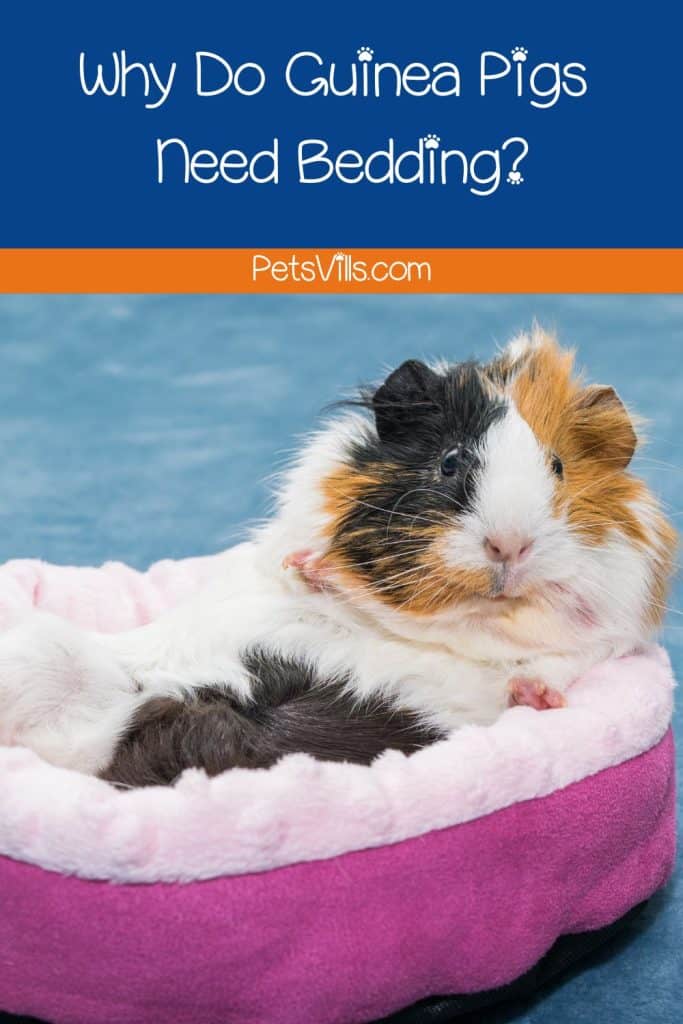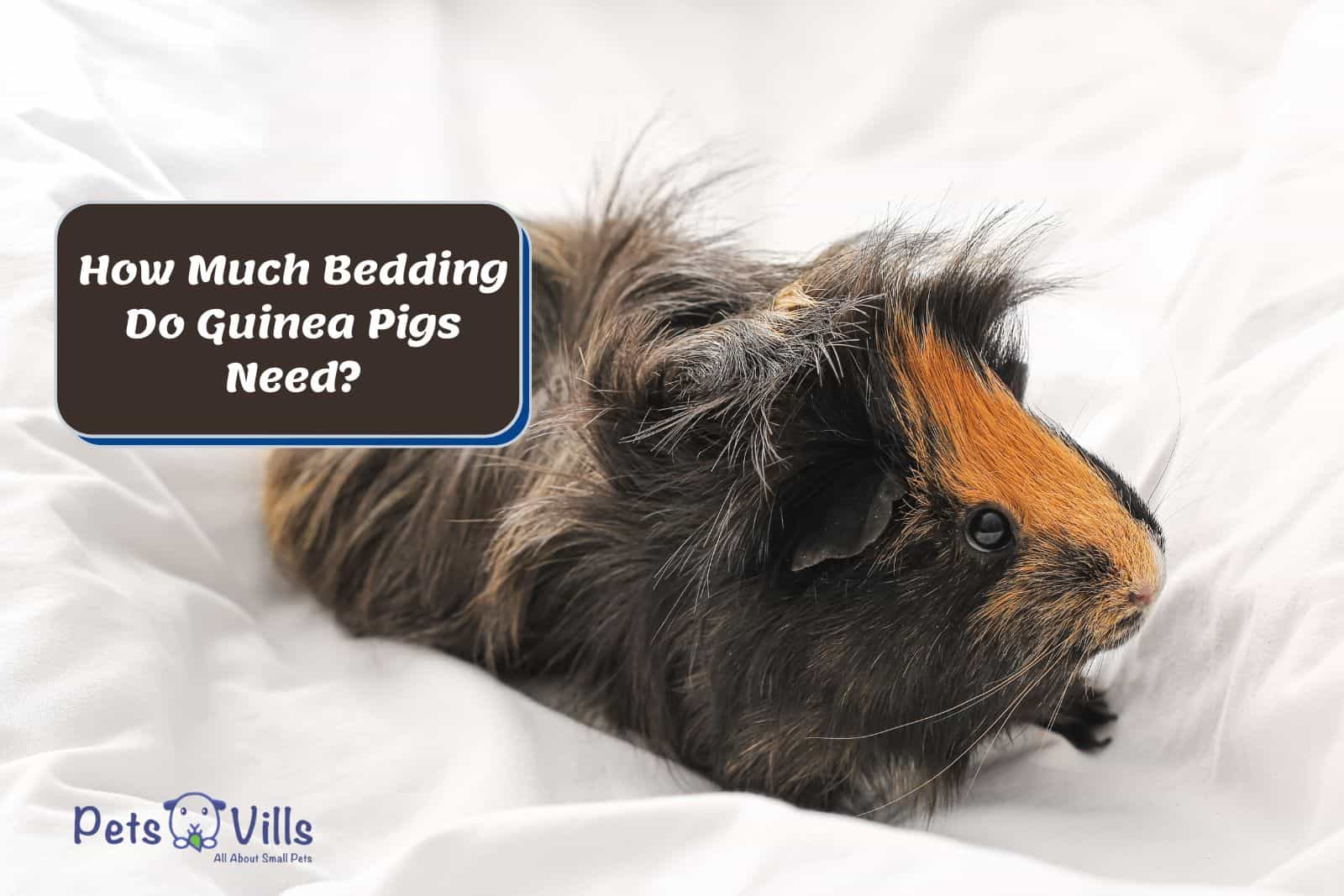Are you wondering how much bedding do guinea pigs need? Here’s what I’ve learned…
As a seasoned pet care expert, I understand how critical the right bedding volume can make all the difference to your furry friends’ comfort and health.
Leveraging multiple studies and my extensive experience, this post will dispel all your doubts and guide you toward creating the perfect habitat for your guinea pigs.
Keep reading to unveil the truth about guinea pigs and bedding, and finally, learn from the best out there (you deserve it!)
Table of Contents
Key Takeaways
- Bedding Quantity: The ideal bedding quantity for a guinea pig is typically 2-3 inches deep, but it can vary based on the type of bedding used and the size of your pet’s cage.
- Bedding Types: Different types of bedding materials have different absorption rates, which can influence how much you need to use.
- Health Implications: The right amount of bedding is crucial for guinea pigs’ health, as it helps manage waste and keeps the habitat clean and comfortable.
Let’s find out everything there is to know: how much bedding do guinea pigs need…
CHECK OUT: guinea pig cage liners for the best liners out there!
How Much Bedding Do Guinea Pigs Need?
If you cared to know about “How much bedding do guinea pigs need,” you’d be surprised to know that there’s a more “in-depth” answer…
To save you time and money, study these 3 must-knows about guinea bedding…
#1 Adequate Bedding Quantity
According to experts at the Animal Hospital of Verona, “Bedding should be provided 2-3 inches deep to reduce strain on feet, allow burrowing, and soak up urine.” [1]
This thickness ensures their comfort while maintaining a clean environment.
#2 Bedding Choices
Choices abound regarding bedding materials, especially when you wish to add more bedding to their cages…
Shredded paper and aspen are common due to their high absorbency.
Alternatively, homemade fleece bedding is a cost-effective and reusable choice that effectively wicks away moisture and can be added without worrying about excess.
#3 Impact of Cage Size
Cage size plays a significant role in determining the required bedding quantity. But what are the exact measurements?
According to an experienced veterinarian, Ira Silver, DVM, “Their cage needs to be bigger than you might think — 7.5 square feet for one guinea pig and 10.5 square feet for two is ideal. [3]”
It serves as a crucial reminder of the spatial needs of guinea pigs, ensuring they have enough room to exercise and roam when adding layers.
Similar to the principle that the size of the back brace matters for providing proper support, the size of the cage influences the amount of bedding needed.
Larger cages naturally require more bedding. However, it is crucial to maintain a balance to avoid wastage and ensure your guinea pigs can move around comfortably.
Why Do Guinea Pigs Need Bedding?
Bedding is essential for these adorable creatures – ensuring their well-being on multiple fronts.
Proper bedding – and the right amount of it – does 4 things…
#1 Cushioning Sensitive Feet
The veterinary team at RSPCA Australia emphasizes the importance of appropriate cage conditions, “Domesticated guinea pigs should be kept on soft floor material and soft bedding material to help prevent ulcerated footpad. [4]”
More specifically, this soft bedding also provides a comfortable place for guinea pigs to rest, making it essential for their well-being [4].
In fact, guinea pig enclosures are often made of materials like wire, metal, or hard plastic, all of which can be tough on the delicate feet of your pet.
Providing them with a layer of bedding creates a cushioned surface for them to walk on and a cozy spot for their sleep, improving their overall comfort.
Think of bedding as a soft carpet instead of a hard, cold floor.
#2 Providing Health and Hygiene
When you go with the highly absorbent bedding, you’ll best maintain a clean and healthy living space for your guinea pigs.
To ensure a healthy living environment for your guinea pig, it’s essential to spot-clean dirty areas daily and fully change the bedding every three to four days, as per Dr. Jones’s recommendation [2].
It soaks up urine and any spilled water, confining the mess to a particular area and preventing it from spreading across the cage.
In addition, certain absorbent materials like aspen or paper bedding help combat odors, reducing the high ammonia content in urine that can harm your pet’s respiratory system and keep your home smelling fresh.
#3 Enriching Mental Well-being
Guinea pigs, being prey animals, are naturally inclined to hide when they feel threatened or stressed.
A generous layer of bedding allows them to exhibit natural behaviors like digging, burrowing, and hiding.
It serves as their sanctuary, enhancing their sense of security and contributing to their mental health.
#4 Regulating Temperature
Lastly, the right bedding can also help regulate the temperature in their habitat. Guinea pigs have a higher body temperature and enjoy warmth.
Certain types of bedding can retain heat, providing additional coziness when your pet burrows deep inside it.
A comfortable, clean, and enriching environment is directly tied to your guinea pig’s happiness and well-being.
So, while setting up your pet’s home, remember that a well-bedded enclosure equals a content guinea pig.
Understanding the quantity of bedding for your guinea pigs is only half the story.
You must also discern the best bedding type for their health and hygiene. With numerous options available, it can be a daunting task for pet parents.
Too much to read? Here’s a clever infographic showing you the basics of this section!

Three Essential Factors That Influence Your Guinea Pig’s Bedding Choices
Venturing into the world of guinea pig parenthood is both exciting and packed with learning opportunities (Note: Other factors may contribute to the need for excess bedding!)
If you’re curious about just how much bedding your friend requires, here are 3 more factors you shouldn’t ignore!
Factor #1: Seasonal Adjustments
Our adorable little guinea pigs, sensitive to their environment, require different care strategies according to the seasons.
As the temperature drops in winter, adding some extra bedding to their enclosure for warmth is beneficial, serving as an insulating layer against the cold.
In contrast, a lighter layer of bedding may be more appropriate during the summer months as insulation isn’t as crucial.
Always remember, irrespective of the season, maintaining fresh bedding is paramount to prevent harmful dampness that could lead to health issues.
Factor #2: Preferences
Guinea pigs, much like humans, are unique beings with personal preferences. Some enjoy burrowing deep into their bedding, while others might be content with just enough to cushion their delicate feet.
Observing your guinea pig’s behavior provides insightful cues about their bedding preferences, allowing you to adjust the quantity to match their comfort levels.
Factor #3: Cage Cleaning Frequency
Your cleaning schedule influences the amount of bedding you’ll require.
Regular spot cleaning can extend the life of the bedding, reducing the amount you’ll need to replenish.
However, if your schedule doesn’t allow for frequent cage cleaning, a thicker layer of bedding may be necessary to ensure your guinea pig’s enclosure remains hygienic and comfortable for extended periods.
While this journey of guinea pig parenthood comes with many variables, remember that the overall goal is to ensure your pet’s safe and comfortable habitat.
Balancing their unique needs, health considerations, and cage size will lead you to create an environment that helps your guinea pig stay happy and healthy.
Remember, your guinea pig’s well-being is the ultimate measure of success!
What Not To Substitute For Guinea Bedding
As a responsible pet owner, it’s equally important to know what not to use as bedding for your guinea pigs.
Corn cob or hay-based bedding should be avoided, as they can grow mold and look deceptively like a snack to your pet, leading to potential intestinal blockages.
Such issues can be harrowing and necessitate veterinary intervention.
Pine or cedar wood shavings must be wholly avoided despite their marketed benefits.
These shavings emit toxins harmful to your pet’s health, particularly affecting their respiratory system and liver, and can prompt a visit to the vet.
Finally, remember that choosing the best bedding for your guinea pig involves evaluating absorbent layers, considering safe options, and avoiding harmful materials.
For additional bedding alternatives you might already have at home, check out my comprehensive article on guinea pig bedding alternatives.
And (as always!) there are more tips! Dive into this video for more sparkling ideas: All About Guinea Pig Bedding…
Now it’s time for a wrap-up – a nifty infographic to summarize everything important:
Frequently Asked Questions
#1. How often should I change my guinea pig’s bedding?
Aim to change the bedding at least once a week to maintain cleanliness and reduce health risks.
#2. Can you overdo bedding for guinea pigs?
Excess bedding can be wasteful and make it harder for the guinea pig to move around comfortably.
#3. What type of bedding is best for guinea pigs?
Paper-based beddings are commonly recommended due to their good absorption and comfort properties.
#4. Does the type of guinea pig affect the bedding amount?
Not really. Bedding quantity is more dependent on cage size and bedding type rather than the breed of the guinea pig.
Conclusion
To truly understand how much bedding do guinea pigs need, you need to study the types of bedding, their costs, and impact on your guinea’s health – here’s what you’ve mastered…
Striking a balance in bedding quantity for your guinea pigs requires an understanding of expert advice, keen observation of your pet’s behavior, and a dash of trial and error.
Armed with these insights, you are now better equipped to create a comfortable, healthy, and nurturing environment for your furry friends.
Remember, your journey as a guinea pig parent involves continuous learning and adapting based on your pets’ specific needs and behaviors. Keep exploring, and enjoy this rewarding journey!

Resources
1. Animal Hospital Of Verona. Guinea_Pig_Husbandry_AHOV [Internet]. animalhospitalverona.com. Available from: https://www.animalhospitalverona.com/uploads/SiteAssets/120/files/resources/Guinea_Pig_Husbandry_AHOV.pdf
2. Jones, VMD L. The Complete Guide to Guinea Pigs [Internet]. www.petmd.com. 2022. Available from: https://www.petmd.com/exotic/general-health/complete-guide-to-guinea-pigs
3. Guinea Pigs [Internet]. chevychasevet.com. [cited 2023 May 24]. Available from: https://chevychasevet.com/articles/general/627579-guinea-pigs
4. What do I need to know about my guinea pigs’ health? – RSPCA Knowledgebase [Internet]. rspca.org.au. 2019. Available from: https://kb.rspca.org.au/knowledge-base/what-do-i-need-to-know-about-my-guinea-pigs-health/

My name is Ben Roberts, and I absolutely love animals. So, naturally, I love writing about them too! As far as my animals, I have a Pit-bull, a Beagle-lab mix, a Chihuahua, and one old cat. Each one of them provides me with a new adventure every day. And the best part is they’re all best friends. Well, except the cat when he gets a little annoyed.
FIND HIM ON: FACEBOOK and TWITTER.
Read his latest ARTICLES
Learn more about Benhere



